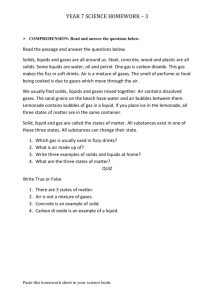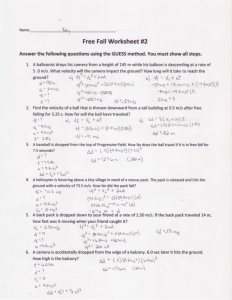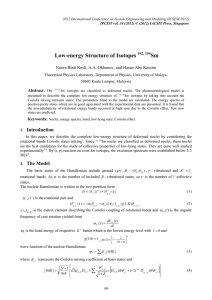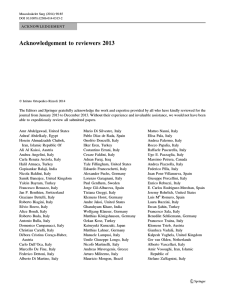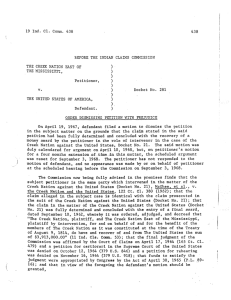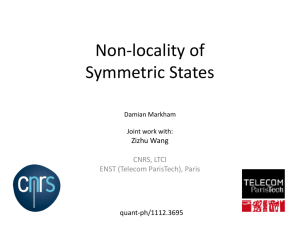Document 13614748
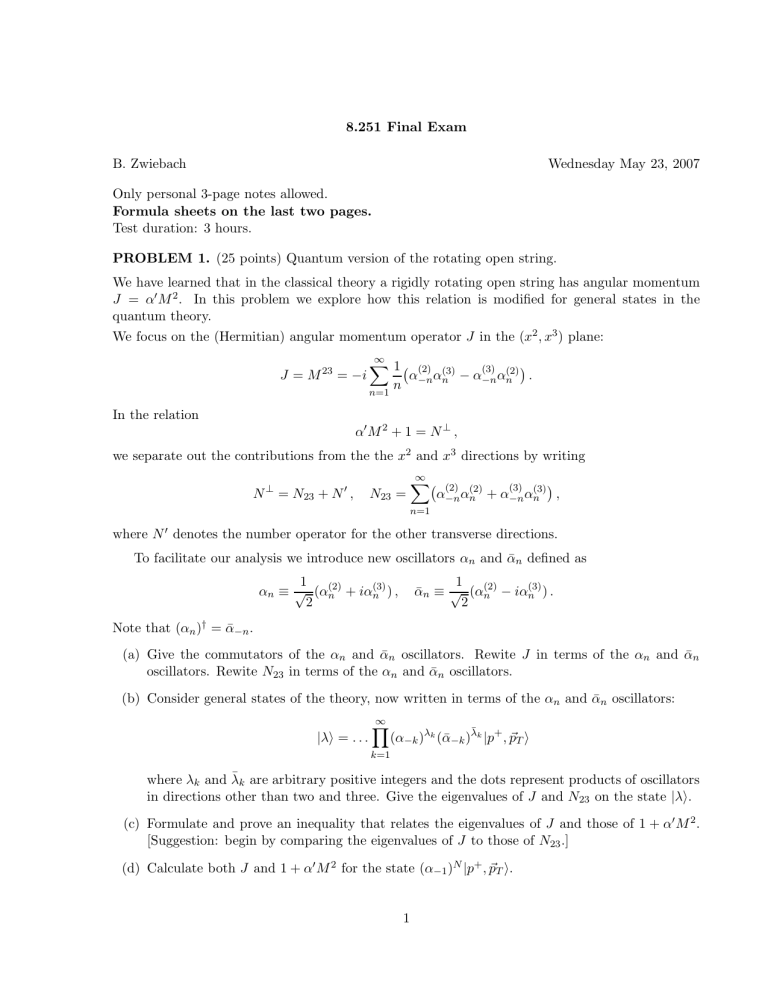
8.251
Final Exam
B. Zwiebach
Only personal 3-page notes allowed.
Formula sheets on the last two pages.
Test duration: 3 hours.
Wednesday May 23, 2007
PROBLEM 1.
(25 points) Quantum version of the rotating open string.
We have learned that in the classical theory a rigidly rotating open string has angular momentum
J = α ′ M
2
. In this problem we explore how this relation is modified for general states in the quantum theory.
We focus on the (Hermitian) angular momentum operator J in the ( x 2 , x 3 ) plane:
J = M
23
= − i
∞
�
1
� α
(2) n
α
(3)
− n n n =1
− α
(3)
α
(2)
− n n
� .
In the relation
α
′
M
2
+ 1 = N
⊥
, we separate out the contributions from the the x
2 and x
3 directions by writing
N
⊥
= N
23
+ N
′
, N
23
=
∞
�
� α
(2)
α
(2)
− n n n =1
+ α
(3)
α
(3)
− n n
� , where N ′ denotes the number operator for the other transverse directions.
To facilitate our analysis we introduce new oscillators α n
α n defined as
α n
1
≡ √
2
( α
(2) n
+ iα
(3) n
) , α n
1
≡ √
2
( α
(2) n
− iα
(3) n
) .
Note that ( α n
) † = α
− n
.
(a) Give the commutators of the α n and ¯ n oscillators. Rewite J in terms of the α n
α n oscillators. Rewite N
23 in terms of the α n and α n oscillators.
(b) Consider general states of the theory, now written in terms of the α n and ¯ n oscillators:
∞
�
| λ � = . . . ( α
− k
)
λ k α
− k
)
¯ k | p
+
, �
T
� k =1 where λ k and λ k are arbitrary positive integers and the dots represent products of oscillators in directions other than two and three. Give the eigenvalues of J and N
23 on the state | λ � .
(c) Formulate and prove an inequality that relates the eigenvalues of J and those of 1 + α ′ M 2 .
[Suggestion: begin by comparing the eigenvalues of J to those of N
23
.]
(d) Calculate both J and 1 + α ′ M 2 for the state ( α
− 1
) N | p + , �
T
� .
1
PROBLEM 2.
(25 points) Cosmic string in de Sitter space.
The Nambu-Goto action on a curved spacetime with metric g
µν
( x ) can be written as before
1
S = −
2 πα ′
� � dτ dσ ( X · X ′ ) 2 − ( X 2 ( X ′ ) 2 where all dot products use the metric g
µν
(instead of the flat Minkowski metric η
µν
)
· X
′
= g
µν
( X ) X
µ
X
ν ′
, ( X
2
= g
µν
( X ) X
µ
X
ν
, ( X
′
)
2
= g
µν
( X ) X
′ µ
X
′ ν
.
We consider strings in an expanding four-dimensional de Sitter spacetime, for which the metric g
µν can be taken to be diagonal, with values g
00
= − 1 , g
11
= g
22
= g
33
= e
2 Ht
.
We are taking c = � = 1. The Hubble constant H has natural units of one over length (or one over time) so that Ht is dimensionless.
(a) Assume and σ
X
0 ≡ t = τ and write X derivatives of X .
µ
= { X
0 } . Write the Nambu-Goto action in terms of
(b) Consider now a circular string on the ( x
1
, x
2
) plane, namely t
X
1
( t, σ ) = r ( t ) cos σ , X
2
( t, σ ) = r ( t ) sin σ , σ ∈ [0 , 2 π ] , where r ( t ) is a radius function to be determined. Use this ansatz to simplify the string action and perform the integration over σ . Write the resulting action as
�
S = dt L ( ˙ ( t ) , r ( t ); t ) and give the explicit form of L ( ˙ ( t ) , r ( t ); t ), which is explicitly time dependent. Because of the e
2 Ht
R ( t ) = e
Ht r factors in the metric, the physically measured radius of the string is actually
( t ). Write the Lagrangian in terms of R and R
(c) Consider strings with constant R and use the Lagrangian to give the potential V ( R ) for such strings. Plot this potential and verify that it is well-defined only if R ≤ 1 /H . Find a critical point of the potential and the corresponding value of R (in terms of H ). Is this static string in stable equilibrium?
(d) Use the Lagrangian for R and R a function of R and R physical motion?
2
PROBLEM 3.
Three short questions (20 points).
(a) Express the open string state
L
⊥
− 2
L
⊥
− 2
| 0 � in terms of normal-ordered oscillators acting on the zero-momentum ground state | 0 � .
(b) State the field content of the massless spectrum of a configuration of N coincident Dp-branes
(let d denote the number of spatial dimensions). What happens to the massless spectrum when we add a coincident orientifold Op-plane?
(c) Two infinite D2-branes intersect at right angles. Recalling that the light-cone gauge requires that the X
1 coordinate have Neumann boundary conditions at both ends, we take the first
D2-brane to extend in the 1- and 2-directions, and the second D2-brane to extend in the 1 and 3-directions. Calculate the value of M 2 for all tachyons in the sector that contains the open strings that stretch from one brane to the other. Where do these tachyons live?
PROBLEM 4.
(30 points) Counting states in Heterotic SO(32) string theory.
In heterotic (closed) string theory the right-moving part of the theory is that of an open super string. It has an NS sector whose states are built with oscillators α
I
− n and b
I
− r vacuum. It also has an R sector whose states are built with oscillators α
I
− n and acting on the NS d
I
− n acting on the
R ground states. The index I runs over 8 values. The standard GSO projection down to NS+ and
R − applies.
The left-moving part of the theory is that of a peculiar bosonic open string. The 24 transverse coordinates split into eight bosonic coordinates X I I
− n and 16 peculiar bosonic coordinates. A surprising fact of two-dimensional physics allows us to replace these 16 coordinates by 32 two-dimensional left-moving fermion fields λ A , with A = 1 , 2 , . . . , 32. The (anticommuting) fermion fields λ A imply that the left-moving part of the theory also has NS ′ and R ′ sectors, denoted with primes to differentiate them from the standard NS and R sectors of the open superstring.
| ′ �
L
, declared The left NS ′ to have ( − 1)
F
L = +1:
I
− n and λ A
− r
( − 1)
F
L | NS
′ �
L
= + | NS
′ �
L
.
The naive mass formula in this sector is
α
′
M
2
L
=
1
�
2 n =0
I I
− n n
+
1
�
2 r ∈ Z + 1
2 r λ
A
λ
A
− r r
.
The left R ′ naive mass formula in this sector is
I
− n and λ
A
− n acting on a set of R ′
α
′
M
2
L
=
1
2
� �
¯
I I
− n n
+ n λ
A
−
λ
A
�
.
n =0 ground states. The
Momentum labels are not needed in this problem so they are omitted throughout.
3
(a) Consider the left NS ′ sector. Write the precise mass-squared formula with normal-ordered oscillators and the appropriate normal-ordering constant. The GSO projection here keeps the states with ( − 1)
F
L
[This is a long list.]
= +1; this defines the left NS
′
+ sector. Write explicitly and count the states we keep for the three lowest mass levels, indicating the corresponding values of α ′ M
2
L
.
(b) Consider the left R ′ sector. Write the precise mass-squared formula with normal-ordered oscillators and the appropriate normal-ordering constant. We have here 32 zero modes λ A
0
.
As usual, half of the ground states have (
Let | R
α
�
L denote ground states with ( − 1)
Keep only states with ( − 1) F
L
−
F
L
1)
F
L = +1 and the other half have ( − 1)
F
L = − 1.
= +1. How many ground states
= +1; this defines the left R ′
| R
α
�
L are there?
+ sector. Write explicitly and count the states we keep for the two lowest mass levels, indicating the corresponding values of α ′ M
2
L
. [This is a shorter list.]
At any mass level α ′ M
2
= 4 k of the heterotic string, the spacetime bosons are obtained by
“tensoring” with
(NS ′
α ′ M
2
R all
= k . Similarly, the spacetime fermions are obtained by tensoring all the left states
+ and R ′ the left states (NS
+) with α ′ M
2
L
= k
′ + and R ′ +) with α ′ M 2
L with the right-moving R
=
− k with the right-moving NS+ states states with α ′ M
2
R
= k . At any mass level where either left states or right states are missing, one cannot form heterotic string states.
(c) Are there tachyonic states in heterotic string theory? Write out the massless states of the theory (bosons and fermions) and describe the fields associated with the bosons. Calculate the total number of states in heterotic string theory (bosons plus fermions) at α ′ M 2 = 4.
(This is a large number!)
(d) Write a generating function f
L
( x ) = � the left-moving sector (include both NS r
′ counts the number of states with α ′ M
2
L a ( r ) x r for the full set of (GSO truncated) states in
+ and R
= r .
′ + states). Use the convention where a ( r )
4
Possibly Useful Formulas
Light-Cone Coordinates:
Slope Parameter: α
′ x ± =
1
2
� x 0 ± x 1 � .
Relativistic Point Particle in Light-Cone Coordinates: x + = p + m 2
τ , p − =
=
1
2 πT
0
.
Light-Cone Gauge:
1
2 p +
� p I p I + m 2 � .
X + = βα
′ p + τ, where β =
� 2 for open strings
1 for closed strings ,
P τ µ =
1
2 πα ′
X µ , P σµ = −
1
2 πα ′
X µ
′
,
( X ± X
′
) 2 = 0 = ⇒ X
−
± X
− ′
=
1
2 βα ′ p +
� ˙ I ± X I
′
�
2
,
µ − X µ
′′
= 0 .
Open String Expansion: X
µ
( τ, σ ) = x
µ
0
+
√
2 α ′ α
µ
0
τ + i
√
2 α ′
�
1 n =0 n
α
µ n e
− inτ cos nσ .
Closed String Expansion: X
µ
( τ, σ ) = x
µ
0
+
√
2 α ′ α
µ
0
τ + i
�
α ′
2
� n =0 e − inτ n
� α
µ n e inσ
+ α
µ n e
− inσ � .
Momentum: α
µ
0
=
√
2 α ′ p µ (open strings) , α
µ
0
=
�
α ′
2 p µ (closed strings).
Commutators, Creation and Annihilation Operators:
� α for
I n n
, α
≥
J m
�
1:
= nδ
α m + n, 0
I n
=
√
δ IJ n
, � x , α
α I
− n
J
0
=
� =
√
√
2 α n a I † n
,
′ i δ IJ , � x , α J n
�
� I m
J n
† � = δ IJ
= 0 if n = 0 ,
δ mn
.
Virasoro Algebra (Open Strings):
α − n
= √
1
2 α ′ p +
L ⊥ n
, where L ⊥ n
≡
1
2
∞
�
α I n − p
α I p
, � L ⊥ m
, α J n
� = − nα J m + n
, p = −∞
� L
L ⊥
0
⊥ m
, L ⊥ n
� = ( m −
= α ′ p p I + N ⊥ n ) L
,
⊥ m + n
N
+
1 m ( m
12
2
∞
− 1)( D − 2) δ m + n, 0
∞
⊥ =
�
α I α I
− p p
=
� n a I n
† a I n
,
, � L ⊥ m
, x I
0
� p =1 n =1
= − i
√
2 α ′ α I m
,
M 2 = − p 2 = 2 p + p
−
− p I p I =
1
α ′
� N
⊥
− 1 � .
Virasoro Algebra (Closed Strings):
α
− n
L ⊥
0
=
1 p +
�
2
α ′
L
⊥ n
α ′
=
4 p p I + N ⊥
, α
− n
,
=
1 p +
�
2
α ′
⊥ n
N ⊥ =
∞
�
α I α I
− p p p =1
, L
⊥ n
≡
1
∞
�
2 p = −∞
α I n − p
α I p
=
∞
� n a I n
† a I n n =1
,
, L
⊥ n
≡
1
2
∞
� p = −∞
L
⊥
0
α ′
=
4 p I p I + N
⊥
, N
⊥
M 2 = − p 2 = 2 p + p − − p I p I
=
∞
� p =1
I I
− p p
=
∞
� n =1
=
2
α ′
� N ⊥ + N ⊥ − 2 �
I † I n n
, N
,
⊥ = N ⊥ .
I n − p
I p
,
5
NS-sector:
Ground state: ( − 1)
F
= − 1 : | NS � .
Normal ordering constant for NS fermion: a
N S
= − 1
48
.
Mass-squared: α
′
M
2
= −
1
2
+ N
⊥
.
α
′
M
2
α
′
M
2
= − 1
2
, N
⊥
= 0 , N
⊥
= 0 :
=
1
2
:
| b
NS �
I
− 1 / 2
,
| NS � ,
α
′
M
2
=
1
2
, N
⊥
α
′
M
2
= 1 , N
⊥
= 1 :
=
3
2
:
� α
I
− 1
, b
I b
J
− 1 / 2 − 1 / 2
� | NS � ,
� α
I
− 1 b
J
− 1 / 2
, b
I
− 3 / 2
, b
I b
J b
K
− 1 / 2 − 1 / 2 − 1 / 2
� | NS � .
NS+ sector: ( − 1)
F
= +1. Integer α ′ M
2
.
R-sector:
8 zero modes: → 4 creation + 4 annihilation. 4 creation → 2 4 = 16 ground states.
Ground states: ( − 1)
F
= − 1 : | R a
� , a = 1 , . . . 8 , and ( − 1)
F
= +1 : | R a
� , a ¯ , . . . 8 .
Normal ordering constant for Ramond fermion: a
R
= +
1
24
.
Mass-squared: α ′ M
2
= N ⊥ .
α
′
α
α
′
M
2
′
M
M
2
2
= 0 :
= 1 :
= 2 : { α
I
− 2
, α
I
− 1
α
J
− 1
, d
I
− 1 d
J
− 1
}| R a
�
{ α
�
| R a
�
�
α
I
− 1
| R a
� , d
I
− 1
| R a
�
�
�
| R
α a
I
− 1
�
| R a
� , d
I
− 1
| R a
� ,
I
− 1 d
J
− 1
, d
I
− 2
}| R a
�
�
�
�
�
{ α
I
− 2
, α
{ α
I
− 1 d
J
− 1
I
− 1
α
J
− 1
, d
I
− 1
, d
I
− 2
}| R a
� d
J
− 1
}| R
¯
�
Left of bars: ( − 1)
F
= − 1, the R − sector. Right of bars: ( − 1)
F
= +1, the R+ sector. f
N S +
( x ) =
2
√ x
∞
� �
� n =1
1 + x n − 1
2 �
8
1 − x n
−
∞
� �
1 − x n − n =1
1 − x n
1
2 �
8
�
= 8
∞
�
�
1 + x n
�
8 n =1
1 − x n
= f
R −
( x ) .
Dp-brane: Oscillators: α i n
, i = 2 , 3 , . . . , p and α a n
, a = p + 1 , . . . , d .
Ground states: | p
+
, � � , � = ( p
2
, . . . p p
).
Mass-squared: α
′
M
2
= − 1 + �
∞
� α i
α i n =1 − n n
+ α a
−
α a � .
Dp-brane and coincident Op:
Ω p action: Ω p
α i
Ω − 1 n p
= ( − 1) n
α i n
, Ω p
α a
Ω − 1 n p
= ( − 1) n
α a n
, ground states invariant.
N parallel Dp-branes: Ground states | p
+ p ; [ j k ] � , j, k = 1 , 2 , . . . , N , p� = ( p
2
, . . . p p
).
If present, Ω p action on the ground states Ω p
| p
+
, � ; [ j k ] � = | p
+
, � ; [ k j ] �
Normal ordering constants: a
N N
= a
DD
= − 1
24
, a
N D
= a
DN
= +
1
48
.
6

